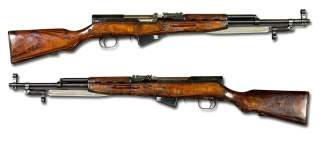The SKS Is the Rifle That Won't Die
Just when you think it was gone...
Key Point: Not as famous as its cousins, the SKS is just as long-lasting.
The most iconic rifle of the 20th century is the AK-47. One of the most iconic rifles of World War II — granted, this is more debatable — is the Mosin-Nagant. Both were developed in Russia.
The SKS, short for Self-Loading Carbine of the Simonov System, is the odd one out.
Developed in the interim between the Mosin-Nagant and the AK-47, Sergei Simonov’s semi-automatic carbine had a mere 10-round internal box magazine, an improvement from the fundamentally 19th-century design of the five-round, bolt-action Mosin.
The SKS shared the 7.62x39-millimeter cartridge with the AK-47, but the latter’s 30-round detachable magazine gave the Kalashnikov the extra firepower the Red Army craved in the immediate post-war years. As a result, the SKS saw limited use in the Soviet military beginning in 1949 — and stuck around primarily in the hands of ceremonial, border and reserve units.
But the SKS remained an adaptable, reliable and high-powered weapon. So much so that it persisted into the 21st century’s wars despite the AK-47 being the overall better weapon for government work.
Accounts differ, C.J. Chivers noted in his 2010 history The Gun, as to whether or not a visiting Chinese delegation to the Soviet Union was furious at seeing the SKS under production. The USSR had until this point largely supplied China with M44 bolt-action carbines.
But regardless of what actually happened, China got the technology it wanted and went on to produce millions of SKSs. Although the debacle of the Sino-Vietnamese War of 1979 would expose the weapon’s limitations and force the Chinese army to upgrade its small arms to the Type 81 rifle, an AK-47/SKS hybrid.
The situation was different in the 1950s and 1960s, and at the time, the SKS was suitable for China’s Maoist military doctrine which placed a priority on basic rifle skills, sniper attacks and ambushes.
While the SKS has a limited ammunition capacity of 10 rounds, this was not a major problem — Maoist cadres mounting a defense of the Chinese mainland were expected to travel light.
For similar reasons, the SKS has remained to this day in insurgent and guerrilla stockpiles — and in some armies — around the world, and has seen use most recently in Syria and Iraq, although the carbines are less common than they used to be.
Ex-Yugoslavian carbines also pop up relatively frequently, although this version has some shortcomings. The Yugoslavian SKS lacks a chrome-lined barrel — a knock to reliability when firing corrosive ammunition — but adds an integrated grenade launching feature.
That’s a bonus if you’re a rebel who has a few rifle grenades lying around, but for most shooters, this makes a simple weapon heavier and more fault-prone than it strictly needs to be, as the Yugoslavian SKS requires a more complicated gas system.
The SKS has an odd place in the civilian world, too. Because China produced so many — and exported so many — the carbine has become a cheap, popular hunting and sporting weapon in the West.
And since an owner must modify the SKS for it to carry more than 10 rounds, the factory versions are a bit easier to acquire in states and countries that restrict rifles with higher-capacity magazines.
The United States also slapped restrictions on imports from the Chinese manufacturer Norinco in 1993, which makes the SKS a rare example of a military rifle that is arguably easier to acquire in Canada, which did not impose similar restrictions — provided you have the proper licenses.
For collectors, the carbine has an added historical and military cachet, with the Soviet versions being among the most highly coveted given their limited production.
Plus, there’s a mean-looking bayonet integrated into the barrel — although the particular style depends on the country of origin. If you like your bayonets pointy, buy the Chinese version. If you’re going for a blade, look for a Yugoslavian SKS.
It’d be a stretch to say that the SKS was ahead of its time. The carbine was a Soviet competitor to the German Gewehr 42 and the American M1 Garand — but more reliable than the Gewehr while much cheaper and easier to acquire into the 21st century than the Garand.
It’s not perfect. The SKS’ free-floating firing pin, if not cleaned and acting properly, can cause this semi-automatic gun to “slamfire,” meaning it begins to fire in automatic with no way to stop it — which is considerably dangerous.
But few would deny the SKS just kept working, in many more places, and long after Sergei Simonov — who died in May 1986 at the age of 92 — could have imagined.

